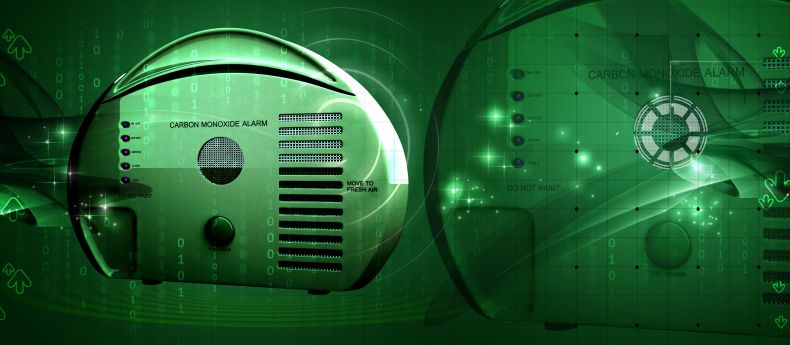
Carbon Monoxide Poisoning: Know the Signs
Why is carbon monoxide poisoning important?
Carbon monoxide (CO) poisoning is a common cause of accidental poisoning with up to 30% of accidental poisonings resulting in death. Accidental poisoning can occur in our homes, especially during the winter months when windows and doors are sealed to keep out the cold. Early symptoms are non-specific and subtle, making CO poisoning easy to miss.
What is carbon monoxide?
Carbon monoxide (CO) is gas which cannot easily be detected, because it has no odor, taste or color, and does not cause skin irritation. Usually there is only a tiny amount in the air we breathe, but it is produced by combustion of hydrocarbons (cars, gas stoves, water heaters) and the concentration of CO can become dangerously high in enclosed environments.
What are common sources of carbon monoxide?
The most frequent cause of CO poisoning is smoke inhalation, such as occurs in a fire. Smoke inhalation typically involves other additional toxins.
Other potential sources of CO are less obvious. Poorly-ventilated fuel-burning devices such as water heaters and gas burners can cause exposure at home and also in neighboring apartments. Other potential sources include generators and motor engines, especially when operating in poorly-ventilated areas such as garages.
Underground electrical cable fires can generate large volumes of CO, which can enter nearby buildings. Another source is methylene chloride (dichloromethane), an industrial solvent present in paint remover, which is metabolized to CO if inhaled or ingested.
Why is carbon monoxide dangerous?
1) Hemoglobin in our blood normally binds oxygen and transports it around our bodies. CO also binds to hemoglobin, forming carboxyhemoglobin (COHb). This effectively blocks the hemoglobin from delivering oxygen to our vital organs.
2) CO can provoke an inflammatory response that causes lipid peroxidation in the central nervous system. This can result in delayed neurological symptoms in about 40% of cases.
3) CO can also prevent tissues such as heart muscle from using oxygen by binding to important enzymes.
What are the symptoms and signs of carbon monoxide poisoning?
Mild CO poisoning can cause headache (90% of cases), nausea, weakness and dizziness. More significant poisoning can cause an altered mental state, which could be mild (slight confusion) or severe (coma). Seizures may occur. CO poisoning can also provoke acute chest pain due to angina or myocardial infarction (heart attack). Other possible symptoms include ventricular arrhythmias (altered heart rhythm), breathlessness due to pulmonary edema, and profound lactic acidosis.
Young children may be fussy or have difficulty feeding. They may also develop signs and symptoms of CO poisoning before older children and adults with the same exposure. The classic description of cherry red lips as a sign of CO poisoning is rarely helpful.
How is CO poisoning diagnosed?
The most important step in diagnosis of acute carbon monoxide (CO) poisoning is for those giving care to patients to think of the possibility.
One difficulty in becoming aware of CO poisoning is that standard pulse oximeters (placed on patients’ fingers in emergency departments to measure oxygen in the blood) cannot differentiate carboxyhemoglobin (hemoglobin bound to CO) from oxyhemoglobin (hemoglobin bound to oxygen) and so give a “normal” reading even in the presence of severe CO poisoning. Blood oxygen (PO2) measurements can also be normal, making it difficult for medical staff, family members, or friends of the victim to tell. Special cooximeters which distinguish carboxyhemoglobin do exist, or a blood gas sample can show an elevated carboxyhemoglobin.
Treatment of carbon monoxide poisoning
At the scene, try to get out of enclosed environments or at least open doors and windows.
Immediate treatment with high-flow oxygen via a non-rebreathing face mask speeds up elimination of CO from the bloodstream. There is some evidence suggesting that hyperbaric oxygen may be even more effective, when this is available, although special precautions must be taken if this is used with young children.
Special attention must be paid to pregnant patients exposed to CO. It is possible for the baby to be exposed to higher levels of CO than the mother, and therefore careful obstetric evaluation is recommended. Evidence suggests that babies do well in cases where the mother suffered mild-to-moderate CO poisoning, but in cases of severe poisoning there may be greater risk of harm.
What other tests should be done?
If significant CO intoxication has occurred, an electrocardiogram (ECG or EKG) is recommended. Further tests may be appropriate for patients with an abnormal ECG or a history of heart disease.
Computed tomography (CT) scans of the head are often performed to investigate altered mental status. A normal result rules out some other causes of neurological symptoms. In rare circumstances, CO poisoning can cause bleeding into the globus pallidus or white matter of the brain.
Is long term treatment necessary?
Although most people who survive the immediate episode do make a good recovery, follow-up is appropriate for two reasons:
1) Injury to the heart muscle (myocardium) may occur in as many as one in three CO-poisoned patients. Cardiovascular assessment is therefore appropriate for all with symptoms of moderate or severe poisoning.
2) Delayed neuropsychiatric effects can be seen in is as many as 40% of adult patients with more severe CO poisoning, (cases involving loss of consciousness). Typically symptoms begin within 20 days of the poisoning, but reports of delayed onset (up to several months) exist. Possible deficits include subtle personality changes, impaired cognition and movement disorders. Delayed neurological symptoms are less common in children with significant poisoning (estimates range from 3% to 17%).
What should I do?
If you suspect CO poisoning:
- Get everyone outside or ventilate the room immediately.
- Go to an emergency room for assessment and treatment, (don’t drive yourself).
- Switch off possible sources of carbon monoxide if possible and alert neighbors.
How can I prevent CO poisoning?
- Put a CO alarm in your home; (this device can be combined with a smoke alarm). If it is powered by a main electrical supply, make sure it has a back-up battery.
- Make sure that all fuel-burning appliances in your home (including the heating system) are installed correctly, well maintained and appropriately ventilated.
- Don’t leave cars running in the garage, (even with the door open).
- Don’t operate indoors generators or grills that are designed for outdoor use.
This was written with reference to material available at the following sites:
http://www.uptodate.com;
http://www.tripanswers.org/; http://www.patient.co.uk





